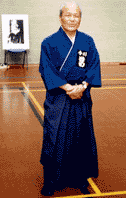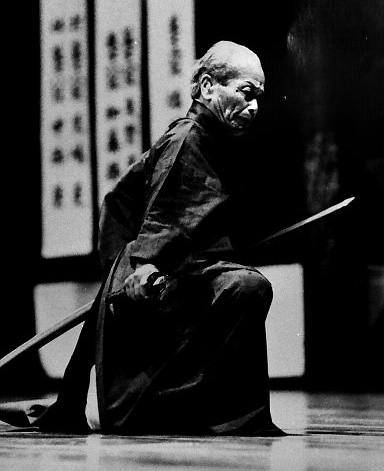ON DEMONSTRATIONS
Oh-e Sensei always started with slow and long movements, then
progressed into Technical performance. I have heard many people say that Uke-Nagashi was one of his specialities.
 |
For example: a) When receiving the attackers blade, pull the left
shoulder back very deeply.
b) Next, bend the body backwards to its full limit.
At the same time the Right hand must be brought up correctly above the
head. The Kissaki must be pointing downwards.
c) Kirioroshi (Kiritsuke) must be done with the right
hand only.
d) Footwork timing must produce Bang
Baang sound, not Baang Bang.
e) Kirioroshi action should be synchronised with the stamping sound
of the right foot. |
These are a typical examples of the Oh-e Sensei method which is distinctly
understandable. His aim was to perform Kata with large movements rather than
slow ones. In my opinion he did this purposefully to allow students to see and
understand the logic of forms. There were always questions concerning the slowness
of movement which Oh-e Sensei created. Some teachers said that it was simply
the differentiation between two great Masters.
As a point of interest I first noticed this way when I was a pupil at Kochi
Junior High School. However it was not until fifty or sixty years later that
I came to the conclusion to agree and obey the Oh-e basic method. If there is
a different method or opinion, I would simply consider it as such.
In other words, there are no observations that I can consider as either right
or wrong. I was brought up in Kochi City (Capital of Kochi Prefecture), and
with that I had never had serious doubts about the methods of Oh-e Sensei. However
today, some sixty to sixty-seven years later I must confess that I am greatly
influenced by his opinions and way of life.
I would like to comment on the Disagreement between the two great men Master
Oh-e and Master Nakayama Hakudo (Of Kendo fame).
I think that this disagreement must have been created due to the differences
of style and age. My own opinion is that Oh-e Sensei was influenced by Hamaguri
Gomon no Ikusa (The Clam Gate War) which took place in the Kyoto Imperial Palace
between 1865~67 at the end of the Edo period. Also because he expended exceptional
energy and effort in instructing fundamental exercises and training.
For some reason we can find a strange but similar logic in Gorin-no-Sho (Miyamoto
Musashi) which states that, The stroke of cutting is exceedingly
important. It must be done by stretching the elbows and swinging downward with
as large a movement as possible . This is the correct way to cut methodically
and technically. It is also written, If the sword
user hurries his action, the cutting line will fall short. Even shorter than
if one is using a Wakizashi. It seems to be very mysterious to find a
similarity between Miyamoto Musashi and Master Oh-e.
Also the two great Masters were said to be big and strong. They seemed to
have a similarity in attitude method and opinion. Master Nakayama not disagreeing
with the methods of Oh-e Sensei could have been the result of a personality
clash.
FUNDAMENTAL MOVEMENTS WERE ESSENTIAL
ALL OF HIS MOVEMENTS HAD TO BE PERFORMED
STRONGLY AND SLOWLY :
There must be some people who consider this movement as childish and immature.
However analytically, if the practitioner keeps repeating the same action, his
speed will increase automatically. Nevertheless it is important to bear in mind
that an intentional increase in speed should be excluded. As a matter of fact,
Lately I often see Instructors and students hurrying to teach or learn a higher
level of movements and techniques which ruin basics. I therefore firmly believe
that a teacher must not force students to rush their progress in speed and technique.
DO NOT FORGET ANY TECHNIQUE
ATTACKING AND DEFENDING HAS ITS OWN KAMAE
:
We must never forget that the techniques of Oh-e Sensei - Nukitsuke, Kiritsuke,
Noto - all have their own separate Kamae, spirit and movement.
For example;
SEIZA SECTION IPPON-ME MAE
a) When you decide to begin your action, you should be looking at your opponent
with full fighting spirit. Even whilst still in Seiza posture, one must mentally
prepare for Nukitsuke action.
b) When taking Nukitsuke action, one must pressurise the opponent by producing
attacking pressure with the Tsukagashira.
c) Furikaburi action : The Kissaki must be brought up under the left ear with
a thrusting action. At the same time when the right hand reaches eye level,
the left hand must grip the Tsuka to raise the sword above the head. At this
stage the shoulders should be square and the chest straight and expanded.
d) After Kiritsuke bring the right fist to the right temple with a full attacking
feeling. This action precedes Chiburui.
e) Chiburui : Standing, bring the left foot to meet the right foot with a
still attacking spirit. The sword must swing through above the head to the front
of the body to finish - Kissaki position is to the right front of the body which
is in Iai-goshi (short sinking posture)
f) Then start to take Noto action : In our style Jikiden, we bring the right
foot back about a step and a half, bending the left knee slightly, but keeping
the right leg fairly straight. (A kind of Iai-goshi).
g) Next Noto : In kneeling on the left, lower the knee straight downward to
the floor very carefully - looking at the opponent with full fighting spirit.
Even after these actions, still take a few moments in Zanshin.

 |
Page 3 |

